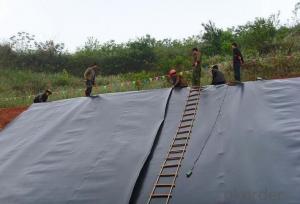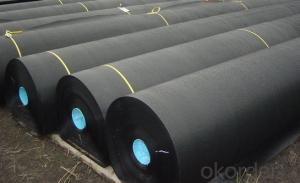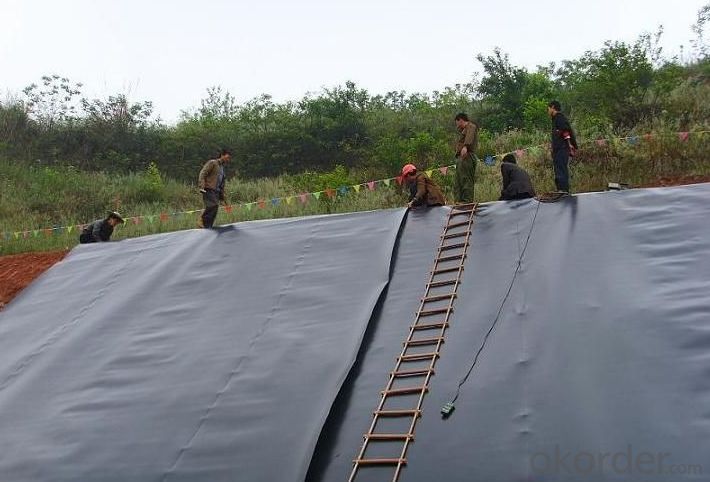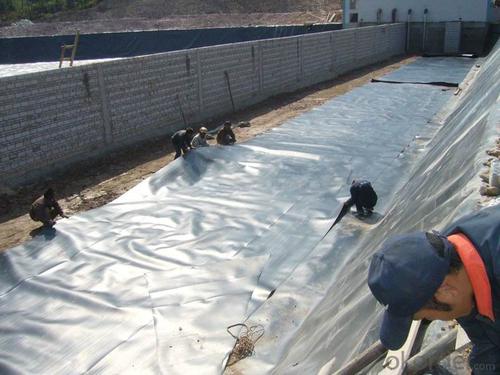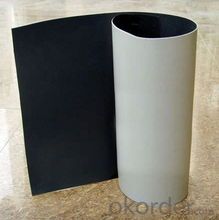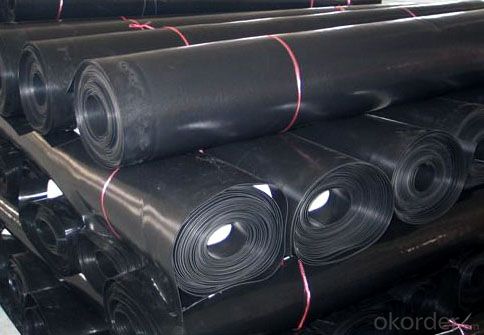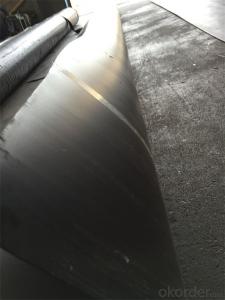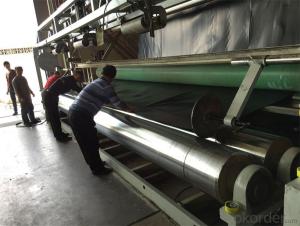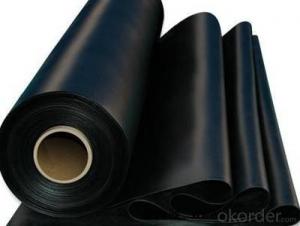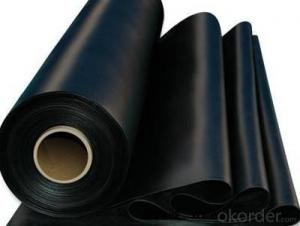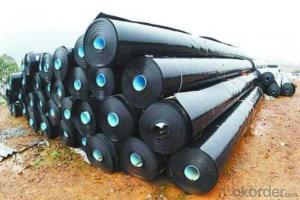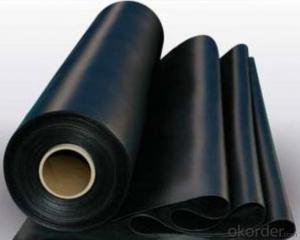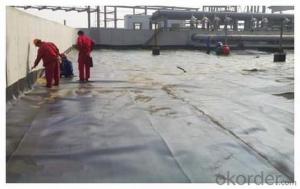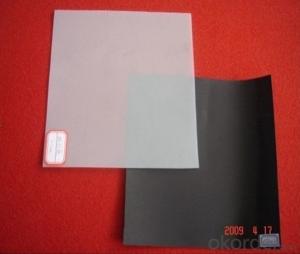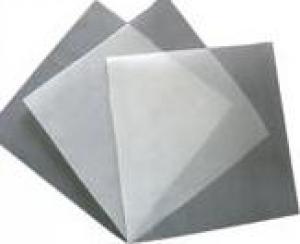1.5mm HDPE Geomembrane for Road Construction
- Loading Port:
- China main port
- Payment Terms:
- TT OR LC
- Min Order Qty:
- 10000 m²
- Supply Capability:
- 5000000 m²/month
OKorder Service Pledge
OKorder Financial Service
You Might Also Like
1.5mm HDPE Geomembrane, Find Details about HDPE Geomembrane and Make an Inquiry for Geomembrane at OKorder.com.
1. HDPE Geomembrane Specifications
1) Thickness : 0.15mm - 4.0mm.
2) Width : Within 8 m (1m-8m).
3) Length : 50m-100m/roll (as request).
4) Material : HDPE,( LDPE, LLDPE, PVC, EVA, etc ).
5) Color : Black , white , red , blue , or as required.
6) Optional surface : Textued(one or two side) or smooth surface.
7) Certificate:CE/ISO9001,14001
2. HDPE Geomenbrane Features
Good mechanical properties, high tear strength, deformation and adaptable, puncture resistance, anti-aging, anti-ultraviolet-resistant, Anti oil and salt, pH, anti-corrosion, high temperature-resistant, non-toxic, long service life. water, drainage, seepage, the good effect of moisture, width, thickness of the full range of specifications and low cost, simple construction.
3. HDPE Geomembrane Applications
1) Environmental protection, sanitation (such as solid waste landfills, sewage treatment plants, power plants Chi-conditioning, industrial, hospital solid waste, etc.) .
2) Water (such as rivers, lakes and reservoirs of the anti-dam, plugging, reinforcement of the canal seepage, the vertical wall of the heart, slope protection, etc.).
3) Municipal Engineering (subway, on the ground floor of the building, planted roof, the roof garden of anti-seepage, sewage pipes lining, etc.).
4) Landscape (man-made lake, river, reservoir, golf courses reservoirs of the substrate, slope protection, green lawn of the waterproof moisture, etc.).
5) Petrochemical (chemical plants, oil refineries, gas storage tanks of the anti-chemical reaction tanks, sedimentation tanks of the lining, etc.).
6) Mining (washing and pool heap leaching, the ash-field, dissolved, precipitation, the yard, the tailings seepage substrates, etc.) .
4. HDPE Geomembrane Show

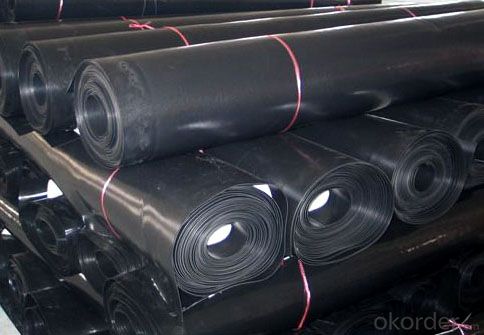
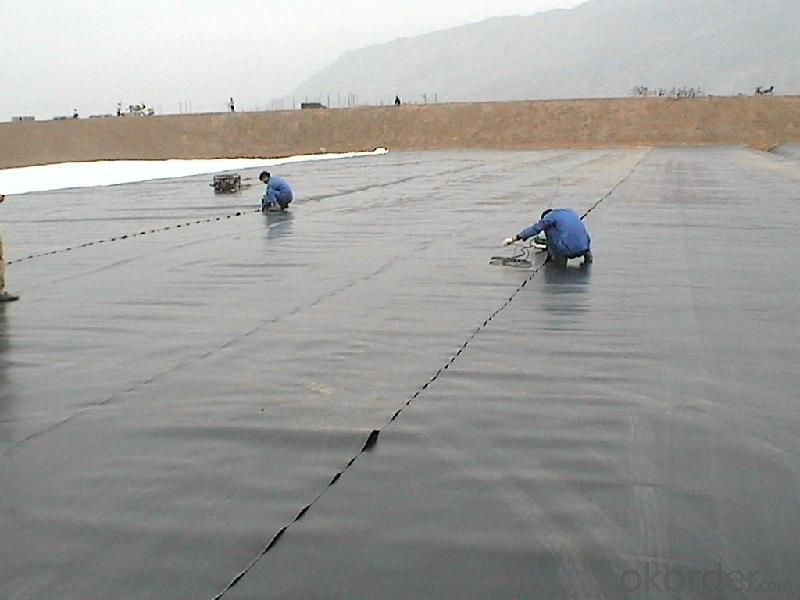

HDPE Geomembrane RFQ:
1. What are we supplying?
We are specialized in producing .geotextile , geocell, geogrid, geomembrane
2. How Many years experience do we have?
We have been exported to more than 15 countries in the past 10 years.
3. How long do we usually reply your request?
We always reply our customer within 12 hours.
If you want to find more details about the non-woven geotextile, you could make an Inquiry in okorder.com. Okorder.com provides you the products with best price and quality!
- Q: What is the water proof method of electric heating film?
- Electrothermal?film is water proof as a whole, can resist high pressure test above 3750V after immersing in water for 48 hours. Its working performance is normal, and there is no leakage phenomenon. So it can be used in humid environment, but pay attention to the waterproofing process between connecting part and clipping part. It has a strong moisture resistance, and is not only resistant to moisture, but also to high pressure, aging. It has long service life with no need for maintaninence. small expansion, having the advantage of stable performance and safe craftmanship.
- Q: Can geomembranes be used in floating solar panel installations?
- Yes, geomembranes can be used in floating solar panel installations. Geomembranes are impermeable liners that can be used to create a floating platform on water bodies, providing a stable foundation for solar panel installations.
- Q: What are the functions of the geomembrane?
- The biggest function is seepage-proofing
- Q: What specification of geomembrane is used by sewage treatment plant ?
- A sewage treatment plant also uses geomembrane? That's what a sewage treatment plant used for preventing percolate from filtering, isn't it? It is advisable that a sewage treatment plant should adopt cement which has better impervious performance?
- Q: Can geomembrane be used in building a methane tank?
- Measures should be taken to prevent seepage in the methan tank.
- Q: What's the service life period of geomembranes?
- The years of working under sewage conditions is 60~90 years. The service life period issue of geomembrane. Thickness used in irrigation works is 0, mainly depending on whether the plastic film loose anti-seepage and water-proof function. The years of working under clean water conditions is up to 80~120 years. According to the Soviet National Standard. 2m plus stabilizer polyethylene film. Therefore, the service life period of geomembrane is sufficient to meet the service life period required by dam seepage-proofing
- Q: What are the considerations for geomembrane selection in hydraulic structures?
- When selecting a geomembrane for hydraulic structures, several important considerations need to be taken into account. Firstly, the geomembrane material must have a high level of impermeability to effectively prevent water leakage. It should also have good resistance to chemical degradation and be able to withstand the specific environmental conditions of the hydraulic structure. Additionally, the geomembrane should have sufficient strength and durability to resist punctures, tears, and other mechanical stresses. Other factors to consider include UV resistance, flexibility, ease of installation, and cost-effectiveness. Ultimately, the selection of a suitable geomembrane should be based on a thorough understanding of the specific requirements and conditions of the hydraulic structure.
- Q: Can geomembranes be used in hydraulic applications?
- Yes, geomembranes can be used in hydraulic applications. They are often utilized as liners or barriers in hydraulic structures such as reservoirs, canals, ponds, and landfills to prevent leakage or seepage of water or other fluids. Geomembranes offer excellent waterproofing properties and are highly durable, making them suitable for various hydraulic engineering projects.
- Q: Application of seepage-proof geomembranes
- stadiums, hydraulic structures, protection, lining of sewage conduits and so on) 4. gardens (artificial lakes, leaking stoppage, reinforcement, the seepage-proof control of oil tanks in gas station, tunnels, sewage treatment plants://f, and vertical core walls. 7. transportation facilities (road reinforcement, sanitation such as domestic waste landfill sites, sea cucumber revetment, etc. 10. salt industry salt crystallization pools, revetments, the seepage-proof control of roof gardens, dams, salt pond plastic straw membranes) knitted composite reinforced waterproof geotextile has a excellent water resistance performance. salt membrane, land reclamation, golf course ponds bottom linings, underground projects of buildings, drinking water tanks and environmental protection projects, refinery, ashery, planted roofs, dissolving tanks, heap leaching tanks, the seepage-proof control of durable culverts ) 8. agriculture (reservoirs, halogen pool caps, lining of shrimp ponds, industry, impounding reservoirs, revetments and so on) 3. municipal engineering (subways, twice linings and so on) 6. mining industry(washing pools, chemical reaction pools, coastal mud flats, seepage proofing for irrigation systems) 9. aquaculture?industry(intensification, lining of settling ponds: //f , fishponds, settling ponds, seepage-proofing of ditches, the water- and moisture-proof control of afforesting lawn etc.) 5. petrochemical industry (chemical plants. It also can be widely used in railways. 2. water conservancy (such as rivers and lakes, the seepage-proof control of reservoirs and dams, factory-like culture ponds, watercourses, storage?yards, power plant regulating reservoirs.
- Q: How do geomembranes perform in extreme weather conditions?
- Geomembranes are designed to be highly durable and resilient, allowing them to perform well in extreme weather conditions. They are able to withstand harsh temperatures, UV radiation, and even freeze-thaw cycles without significant degradation. Additionally, geomembranes have excellent resistance to chemicals and can maintain their integrity in heavy rainfall, strong winds, and intense sunlight. Overall, their exceptional performance in extreme weather conditions makes them a reliable choice for various applications, such as landfill liners, pond liners, and mining containment systems.
Send your message to us
1.5mm HDPE Geomembrane for Road Construction
- Loading Port:
- China main port
- Payment Terms:
- TT OR LC
- Min Order Qty:
- 10000 m²
- Supply Capability:
- 5000000 m²/month
OKorder Service Pledge
OKorder Financial Service
Similar products
Hot products
Hot Searches
Related keywords
